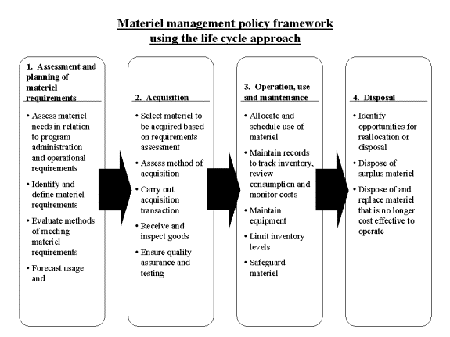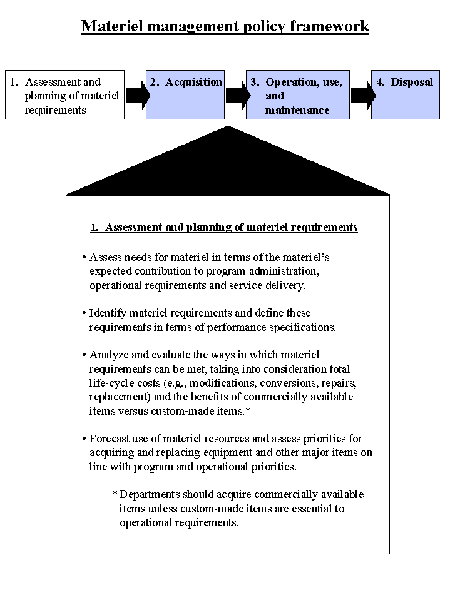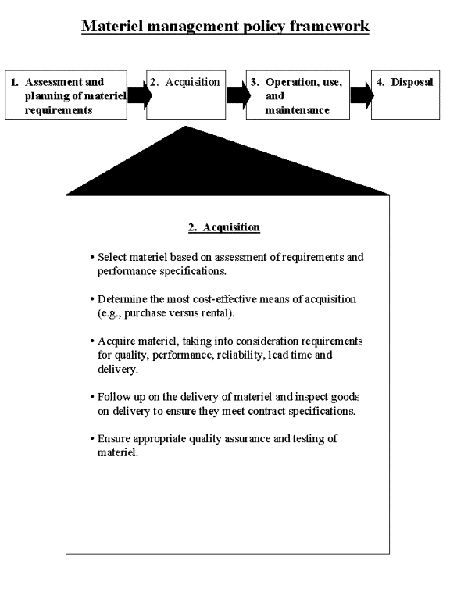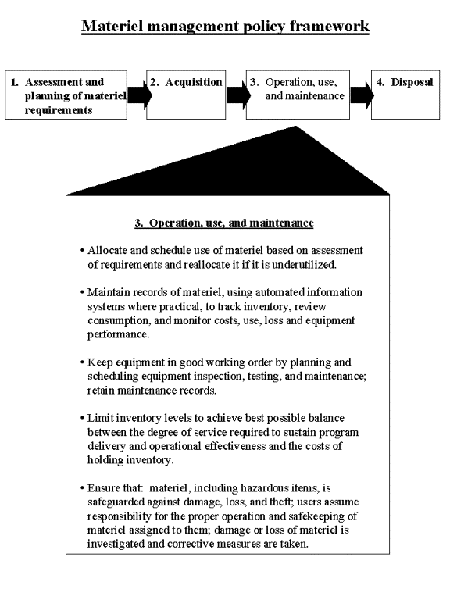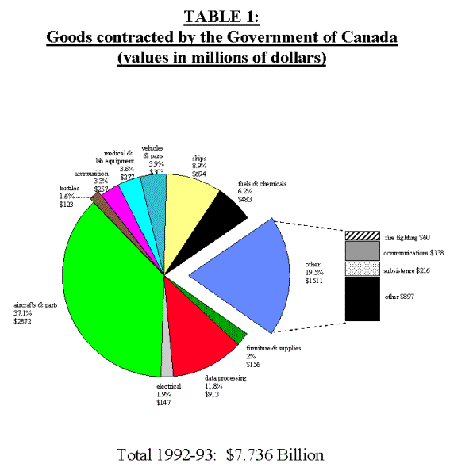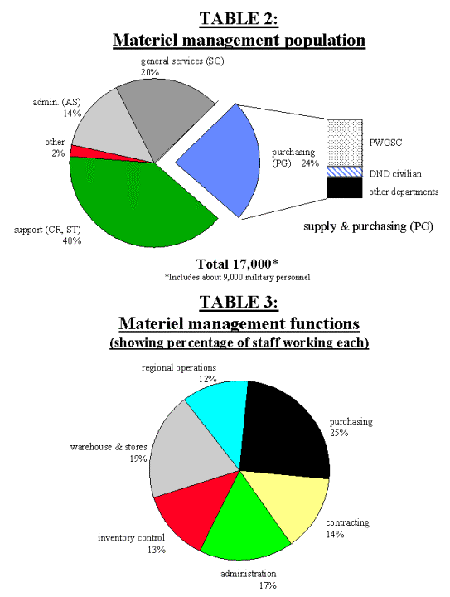Rescinded - Materiel Management Policy
This page has been archived on the Web
Information identified as archived is provided for reference, research or recordkeeping purposes. It is not subject to the Government of Canada Web Standards and has not been altered or updated since it was archived. Please contact us to request a format other than those available.
1. Effective Date
The present document contains the entire text of the policy as approved on June 8, 1995 and replaces the version dated April 15, 1994.
2. Policy objective
The objective of this policy is to ensure that materiel meets departmental operational requirements for effective program delivery and that the government and departments achieve value for money when planning, acquiring, using and disposing of materiel assets.
3. Policy statement
It is government policy that departments:
- acquire and manage materiel in a way that economically supports their operational and program requirements;
- plan for, acquire, store, transport and dispose of materiel in a manner that supports government environmental objectives, and in accordance with federal and provincial legislation and policies; and
- provide employees with materiel required to carry out their work in an efficient, economic, productive and safe manner.
4. Application
The policy applies to departments and agencies listed in Schedules I and II of the Financial Administration Act and to branches designated as departments for purposes of the Act.
5. Policy requirements
- Departments must manage their materiel resources consistent with a
life-cycle approach that incorporates the following phases:
- assessing and planning materiel requirements;
- acquiring materiel resources;
- operating, using and maintaining materiel; and
- disposing of and replacing materiel.
- Section 1 of Appendix A illustrates the life-cycle materiel management policy framework.
- Departments must use automated information systems and supporting technology to manage materiel resources and materiel management functions, when these systems are cost-effective and can improve the materiel management function.
- The full cost of inventories (purchasing and holding cost) must be visible to and distributed to the end user.
- Departments must provide furniture, materiel and equipment to employees in an equitable manner consistent with the services being provided.
- Disposal requirements and authorities are set out in Appendix A.
6. Monitoring
- Feedback on the implementation and effectiveness of this policy will be obtained from sources such as departmental monitoring information, internal audits, and program evaluations, as well as from periodic reviews by the Treasury Board Secretariat.
- The Materiel Management Review Guide published by the Treasury Board contains a comprehensive list of the key questions to ask when monitoring and auditing the materiel management function.
7. Enquiries
Please direct all enquiries about the implementation or application of this policy to:
Bureau of Real Property and MaterielProgram Branch
Treasury Board Secretariat
L'Esplanade Laurier
10th Floor, East Tower
140 O'Connor Street
Ottawa, Ontario
K1A 0R5
Appendix A- Guidelines
1. Materiel management policy framework
The following is a list of graphical representations of the life-cycle/ approach to materiel management that are contained in this appendix.
- Materiel management policy framework using the life-cycle approach
- Phase 1: Assessment and planning of materiel requirements
- Phase 2: Acquisition
- Phase 3: Operation, use and maintenance
- Phase 4: Disposal
2. Strategic direction for materiel management
- More than 17,000 employees are involved in materiel management; they
have a direct impact on the purchase of more than $10 billion worth of
goods and services annually and on the management of government materiel
holdings estimated to be in excess of $50 billion.
(see tables 1 to 3) - The purpose of managing materiel throughout its life cycle is to assist in the proactive, affordable, efficient and effective delivery of government programs.
- The three strategic priorities for the management of government materiel are to:
(i) Improve service at reduced cost:
- introduce process improvement and value-added services;
- reduce overhead costs;
- reduce cost of acquisition, use and management of materiel;
- use readily available life-cycle information effectively;
- obtain best value for materiel purchased/disposed of;
- consider all costs in decision making (i.e. inventory carrying costs);
(ii) ensure an informed, proactive and flexible work force:
- through employee empowerment, training, job enrichment and organizational improvement;
- encourage decision making at the lowest practicable level;
- encourage innovation and a results-oriented environment;
- use a risk management philosophy that recognizes the inherent possibility of mistakes, while providing a supportive environment for employees;
(iii) use technology where it counts:
- use open systems, integration, interconnectivity and standards;
- implement Electronic Data Interchange, electronic forms, bar coding, etc.;
- innovate through competition and business case assessment; and
- share technology, don't reinvent it.
3. Automated materiel management information systems
- A materiel management data base structure, AIM (Assets Information Management), has been developed and forms an integral part of the government's common administrative systems standards.
- Before introducing systems, departments should review this data base structure and assess their organizations' materiel management information technology needs. This task involves evaluating existing manual and automated information systems, assessing current and future organizational needs, and reviewing alternative means of satisfying information needs, including re-engineering the process.
- A number of existing departmental systems have been evaluated and are recommended for consideration. For further information call the Information Management, Systems and Technology Branch, Treasury Board Secretariat.
- To enhance organizational efficiency, departments should fully integrate materiel management systems with corporate planning, budgeting, real property, personnel and financial systems and should design their systems to interface with common service systems.
- Systems should be designed to improve service quality; increase staff productivity and overall performance; reduce unit costs; provide more timely information for all staff levels; reduce person-year operating and maintenance costs; and facilitate cost avoidance. Systems should be based on existing policies, guidelines and systems and, when available, commercially developed solutions or custom applications already running in government.
- When implementating systems, the human factor is an important consideration. It should be included in the business case assessment, which will also address such criteria as feasibility, risk, return on investment and improvement of Canadian industrial competitiveness.
4. The role of the materiel management function
4.1 Changing environment
Over the past decade, federal materiel acquisitions have grown in magnitude, variety and technical complexity. This growth has had a major impact on budgeting for capital expenditures, operations and maintenance. In addition, new demands have been placed on staff, influencing their roles responsibilities and work environment. In response to these demands, materiel managers are moving away from routine purchasing, physical distribution and inventory control, toward more involvement in long-term planning, advisory activities and departmental management. The management of the departmental materiel management function includes developing purchasing strategies, logistics planning, life-cycle costing of acquisition alternatives, and solving daily operational and maintenance problems.
4.2 Structuring the function
- Because of the diversity of departments and program requirements, there is no ideal way to organize the materiel management function. Most federal departmental materiel services are organized as functional entities with varying degrees of centralization or decentralization at the headquarters, regional and district levels. The one common element is that the materiel management function supports the deputy minister, who is ultimately responsible and accountable for departmental activities.
- The materiel management function's responsibilities include long- and short-range acquisition planning and participation in procurement strategy reviews, as well as ensuring that day-to-day operations are carried out in a cost-effective manner, and in accordance with the law and with government policies and standards.
- Materiel staff support the deputy minister and those people providing central direction and services to a department. At the program level, the duties of materiel staff include assisting program heads and their advisers to interpret and apply departmental requirements in a way that satisfies the particular needs of each program. Materiel staff may be located at regional, district and sub-district sites whenever operational and service requirements warrant a decentralized materiel structure.
4.3 Function of the departmental materiel manager
Materiel represents a significant departmental resource. A member of the department's executive should be designated as the senior officer responsible for the management of materiel resources and systems. This senior officer is responsible and accountable for:
- linking the materiel management function effectively with corporate management priorities, departmental operations, Treasury Board policies, common service provider requirements, and a range of other government priorities and objectives, such as environmental or regional concerns;
- ensuring that materiel management systems comply with government policy and standards;
- providing direct or functional authority for all facets of life-cycle materiel management;
- building and maintaining the professional capability of department personnel to ensure that materiel is provided, used and disposed of in an efficient, cost-effective manner in the delivery of departmental programs;
- developing putting in place and maintaining effective monitoring and control mechanisms to ensure that departmental life-cycle materiel management processes and the use of all materiel acquired (through purchase, gift, barter, production, etc.) support departmental programs in an efficient, cost-effective manner;
- ensuring that departmental management, monitoring and control systems are adequate to protect the Crown's materiel, after evaluating the risk of misuse, theft or loss of that materiel;
- promoting the acceptance and use of environmentally sound products and practices by departmental managers;
- ensuring delegation of materiel management authorities including contracting, as fully as possible, to line managers and other employees so that they can carry out their work in the most efficient and effective manner;
- ensuring that materiel is used to the fullest extent possible, by encouraging the transfer, sharing, leasing, sale or barter of materiel within and between departments;
- ensuring the effective and efficient management of all inventories and inventory cost distribution, while keeping expenditures and inventory levels to a minimum; and
- representing the department on materiel management matters.
4.4 Function of line managers
Line managers are responsible for the day-to-day activities associated with planning acquisition, use, custodianship and disposal of materiel. Their functions include
- coordinating the development of materiel and logistics objectives and operational plans that are consistent with corporate goals, government policy (including environmental objectives) and legislation;
- ensuring that the purchase, use and disposal of materiel are in accordance with delegated authorities;
- ensuring that government environmental initiatives are supported throughout the life cycle of materiel;
- ensuring that materiel purchased, produced (prototypes) or acquired through any other means is suitably identified and tracked as appropriate;
- ensuring that materiel is used in an efficient, cost-effective manner in the delivery of operational and program requirements;
- ensuring that data for government and departmental management information systems are collected consistently, are complete, and are processed in an efficient and timely manner; and
- ensuring that employees engaged in the materiel management function are trained and have adequate tools to carry out the work in a safe, efficient and productive manner.
5. Training
- Departmental managers are responsible for ensuring that their employees' knowledge and skills in materiel management are at the levels required to support the implementation and delivery of government programs.
- Employees are responsible for identifying, with their supervisors, areas in materiel management where their skills and knowledge require improvement to enable them to perform their jobs properly.
- Sources of training include Training and Development Canada's Materiel Management Professional Development Program, the Purchasing Management Association of Canada, and the Canadian Association of Logistical Managers.
- The Materiel Management Assignment Program (MMAP) is another tool to help managers develop their human resources by identifying potential assignments in all facets of materiel management and arranging for the placement of assignees. The MMAP is used primarily by employees who wish to develop their careers by making themselves available for assignments or transfers in their field of expertise or in other areas in which they have an interest. For more information contact:
Bureau of Real Property and Materiel
Program Branch
Treasury Board Secretariat
L'Esplanade Laurier
10th Floor, East Tower
140 O'Connor Street
Ottawa, Ontario
K1A 0R5
6. Environment
- The government of Canada has adopted a Code of Environmental Stewardship outlining the government's commitment to a better environment.
- Materiel and line managers must include environmental considerations in all aspects of managing materiel, from the planning phase through acquisition, use and disposal of materiel.
6.1 The life cycle approach and the environment
Applying the four Rs (Reduce, Reuse, Recycle and Recover) at each phase of the materiel management life cycle helps protect the environment and reduce costs.
6.1.1 Planning
During the planning process, materiel and line managers
- assess the need for a given purchase and, whenever possible, reduce consumption;
- consider acquiring second-hand or used materiel;
- consider products that are less damaging to the environment, such as those made with resource-saving materials or processes. These products often carry the EcoLogo; and
- consider the environmental cost of purchases during each phase of the life cycle.
6.1.2 Acquisition
As much as possible, products selected should:
- be reusable and contain reusable parts;
- be recyclable and contain recycled materials (e.g. recycled paper, reconditioned laser printer cartridges);
- include second-hand or used materiel;
- use resources and energy efficiently;
- have a long service life or be economical to repair; and
- contain minimal packaging, or use returnable or reusable shipping containers (National Packaging Protocol).
6.1.3 Maintenance and Operations
- Ensure that products are properly maintained and used. This will extend the service life of a product. When economically feasible, equipment should be repaired, refinished and reused.
- Hazardous materiel must be shipped, stored and handled in accordance with applicable federal and provincial law, and regulations.
6.1.4 Disposal
Consider alternatives to disposing materiel, such as reusing, recycling or recovering it. Try to generate as little waste as possible. See disposal guidelines.
6.2 Combining environmental actions with fiscal responsibility
- Government interest in economy of operations is fully compatible with environmental interests. Many sound environmental practices have resulted in savings.
- Most environmental actions can be phased in gradually without additional cost. When these actions may entail additional costs for the government, managers should accommodate them within existing budgets.
6.3 The Canadian Environmental Protection Act and other legislation
Legislation such as the Canadian Environmental Protection Act (CEPA), the Fisheries Act, the Transportation of Dangerous Goods Act, and the Pest Control Act requires that we manage materiel in an environmentally responsible manner. Under the provisions of the CEPA, public service employees are personally liable for any unlawful activity committed. Management, supervisors and other persons who share a responsibility in the unlawful act may also be held accountable as accomplices. In order to carry out their advisory role and their materiel management functions in an environmentally responsible manner, materiel managers and their staff should understand the applicable environmental legislation.
6.4 Reference
The Office of Federal Environmental Stewardship in Environment Canada acts as a clearinghouse for information and provides advice.
7. Purchasing/acquisition
- Acquisition cards are an effective way to purchase goods and services. They are normally issued to all responsibility centres and to employees carrying out the contracting/purchasing function (i.e. employees with contracting delegation). The cards should have a reasonable credit limit; the limit should be based on program requirements and assessed risk.
- It is government policy to seek competition whenever practical. For low-value purchases, it is not necessary to receive written submissions; catalogue comparisons, advertisements and telephone calls can be used. Departmental materiel managers should put in place an acquisition process that encourages competition, reduces costs and improves productivity while taking due consideration of risk and delegated authorities.
- Government departments should consider leases to meet operational requirements. The selection of the appropriate option whether it is to purchase, lease, make or buy an item should be based on a cost-benefit analysis of operational effectiveness and materiel life-cycle value (including estimated return on disposal).
- Performance specifications and/or applicable generic standards should be
used when purchasing materiel. Consider
- qualified product lists
- qualified companies
- ISO 9000
- Canadian standards
- Treasury Board Information Technology Standards (TBITS)
- Eco-Logo products
- Second-hand materiel and materiel being disposed of by departments should be considered for reuse or deployment before a decision is made to purchase new materiel.
8. Furniture and furnishings
- In assessing furniture requirements the following standards may be of
help:
- National Standard of Canada CAN/CSA-Z412-M89, "Office Ergonomics"
- CAN/CGSB-44.200-M, "Posture Chairs"
- Specialized furniture and equipment for people with disabilities or health problems should be acquired, or existing furniture should be modified, when it is cost effective to do so.
- A medical certificate is not required to justify any such purchase. However, the manager should be convinced that the purchase will resolve the problem. Because of the unique nature of this type of furniture and equipment, departments should facilitate its transfer with the employee as long as the employee remains with the federal government.
9. Inventory management
- It is conservatively estimated that the government holds between $8 and $10 billion worth of materiel in warehouses. These holdings are estimated to cost the government between $2 and $2.5 billion per year to maintain (based on industrial standards of a carrying cost of 25 per cent of the purchase price per annum). This estimate consists of the cost of money (8 to 10%), facilities and labour (12 to 14%), and loss and shrinkage (3 to 6%).
- A review of departmental inventory management practices showed that a
significant portion of materiel held in warehouses was readily available
commercially or could have been acquired in a manner that would have made it
unnecessary to stock it. Among the many factors and forces that result in the
build-up of unwarranted inventories, the most significant are:
- lack of knowledge about the extent and nature of inventories and about the magnitude of related inventory management and holding costs;
- outmoded and inappropriate attitudes that result in the build-up of excessive "just-in-case" inventories;
- lack of financial and other incentives, so that managers neither suffer the consequences of wasteful inventory practices nor reap the rewards of prudent inventory practices;
- institutional barriers to prudent and timely procurement practices; and
- inappropriate and rigid policies and regulations that in some cases make it mandatory to build up large but otherwise unjustifiable inventories or to hold inventories for excessive periods at considerable cost.
- Departmental materiel managers are responsible for ensuring:
- the maintenance of mechanisms to identify, measure and distribute full inventory costs to the end user (e.g. charge-back systems, revolving funds or working capital advances, etc.);
- that managers are trained and provided with incentives and authorities to manage inventories at minimum levels, in an efficient, cost-effective manner;
- that managers do not stock items that are readily available from commercial sources or maintain stocks of government-owned materiel when other cost-effective supply methods are available;
- the effective use of facilities through activities such as transfer of custodianship of special-purpose facilities to departmental users; and
- the use of private-sector storage, warehousing and distribution services, where cost effective, to take advantage of their expertise and economies of scale.
9.1 Inventory and materiel-in-use tracking
- To manage materiel properly, organizations must know what materiel they possess and where it is. However, the resources devoted to such activities should take due consideration of cost and risk. Generally, there is little point in spending $5 to track a $1 item.
- To help them manage materiel, managers are often assigned responsibility for the security of materiel purchased or produced by or for them.
- At other times, responsibility for materiel security is assigned at the corporate, regional, district or other managerial level. There is no ideal way of assigning responsibility for materiel.
- In general, only materiel with a purchase price or production cost (prototype) in excess of $1,000 should be managed on an individual basis. Information on this materiel is, in most cases, carried in an inventory or materiel-in-use data base. The minimum information held would normally be price, quantity, supplier, date of acquisition, manufacturer's part or identifier number and NATO stock number.
- Other materiel, including materiel in use, should be managed in a
cost-effective manner that balances the cost of tracking and control with the
risk associated with loss, fraud, theft, etc.
Note: The minimum information for all materiel acquired (through gift, purchase or production) will be held on a data base. The data base could be that of the financial system or an other system. - Intangible materiel such as software licensing agreements, once recorded as a purchase, should generally not require tracking. It should be identified in a data base. When handling intangibles, organizations should respect security and information technology policies.
- Organizations should take regular physical counts of materiel inventory
and materiel in use. The following are suggested practices:
- Non-consumable once every five years. Departments could count it on a staggered basis.
- Consumable inventory once every two years. Examples of consumables are office stationery and supplies (including such items as low-value hand-held calculators), garage and laboratory supplies, building supplies, petroleum, medical supplies, items for sale such as maps and books, food and non-repairable spare parts.
- When materiel is included in an assembly that is tracked as such, that is a single large accountable asset, or that is affixed in or to real property and legally forms part of the property, the materiel may be treated as a consumable and restocked if it is subsequently recovered. For tracking purposes, the recorded cost of the assembly would not have to be changed unless the incorporation of the materiel significantly changed its value.
10. Employee use of materiel off government premises
- There may be occasions when employees need to take Crown-owned materiel from Crown premises for work-related reasons. If the materiel is lost or damaged while it is off Crown premises, the employee is not normally responsible for its replacement, unless the loss or damage was caused by an intentional omission or commission of any act amounting to a wrongful act or negligence.
- Managers should treat any loss as they would any other materiel loss. Employees are not expected to carry extra insurance. However, if the employee's normal insurance covers the item lost, it is expected that the government will recover its loss.
- Managers should maintain a record of the materiel used by employees off premises, and the materiel should be accounted for as if it were still held on government premises. The use of such materiel is not considered to be subject to Public Property Loan Regulations. Managers should ensure that all the Crown's legal obligations are respected (e.g. software licences).
- The materiel is always Crown property; when it is no longer being used for work-related duties, managers are responsible for its recovery. Except in unusual circumstances, the materiel should be declared surplus only on Crown premises.
11. Departmental transfer of materiel
The loan or transfer of one department's materiel to another department or agency is strongly encouraged, when the use of the materiel is in support of government programs and the use or exchange is cost effective for the government as a whole.
12. Loan of government materiel
- Ministers of the Crown and departmental corporations included under Part III of the Financial Administration Act may enter into a loan agreement. Departments are encouraged to seek appropriate ministerial delegation to facilitate loan agreements.
- The lending of departmental materiel to Crown corporations, other governments' agencies or the private sector must take place only in support of delivery of federal government departmental programs or activities.
- The Public Property Loan Regulations state that every loan of public
property shall initially, except in emergencies, be by way of a contract in
writing that shall include:
- an undertaking that the borrower will indemnify Her Majesty for, and save Her Majesty harmless from, all losses and claims of any kind in respect of the borrower's use or possession of the public property;
- a statement that the lending authority may, at any reasonable time, inspect the public property and view its state of repair;
- the term of the loan;
- a complete description of the consideration for the loan; and
- identification of any security arrangements that the lending authority requires.
- Further, except where the loan is associated with the execution of other contracts, any cost arising from it would be borne by the borrower.
- (e) A loan agreement should also contain, when applicable, statements related
to the following elements:
- a complete description of the materiel being lent (the materiel on loan must be inventoried in a departmental system);
- the quantity of the materiel and its inventoried value;
- the purpose of the loan and the use to which the materiel on loan can be put;
- responsibility for the care and custody of equipment on loan;
- insurance requirements;
- place of pick-up and return of materiel;
- responsibility and requirements for packing and transportation;
- sole agreement, or relationship with or precedence of other agreements; and
- assignments and other restrictions.
13. Disposal, including write-off
13.1 Write-off and disposal
- Disposal and write-off apply to all materiel that has been purchased, produced or acquired by the Crown, irrespective of whether it is recorded in an inventory data base or is an intangible asset.
- The deputy minister has full authority to authorize the write-off of materiel: due to inventory shortage, destruction, fire, theft, loss and other reasons. It should be noted that write-off does not authorize a loss due to fire, theft, etc., but rather authorizes amendment of records to adjust for a previous event.
- It is strongly recommended that the deputy minister's authority for write-off and disposal be extended to appropriate departmental levels.
- A reporting mechanism must be in place to ensure reporting for public accounts purposes.
- Managers should recommend write-off or disposal to the appropriate departmental level, but managers should not have the authority to write off or dispose of materiel for which they are directly responsible.
13.2 Disposals and trade-ins
- When materiel (not including real property and seized goods) is beyond cost-effective repair or is surplus to the Crown's requirements, it should be declared surplus and disposed of in a manner that obtains best value for the Crown.
- Before disposal or trade-in, information on the materiel should be shared within and between departments, and every effort should be made to relocate usable materiel cost effectively within federal departments and agencies.
13.3 Trade-ins
- Departments must establish the appraised fair market value of the assets they wish to trade in to ensure that best value is obtained for the Crown.
- A fair market price must be negotiated for trade-ins. Trading in of vehicles should be more the exception than the rule.
- For departmental accounting and audit purposes, departments are responsible for maintaining adequate records concerning trade-ins.
- Departments have the authority to make trade-ins, this authority should be reflected in departmental delegations.
13.4 Disposal other than trade-ins
- Authority to dispose of surplus materiel and authority for the transfer of title should be reflected in departmental delegations.
- Departments are required to identify and declare their surplus computer hardware, software and associated information technology to Industry Canada's Computers for Schools program.
- Disposal of any materiel declared to Industry Canada's Computers for Schools program and not selected by the program remains the responsibility of the original department.
- Departments and agencies and their agents must ensure that surplus assets (non-forfeited) are advertised to other departments and agencies, which shall have the right of first refusal under normal market conditions (price). Advertising costs and scope should be commensurate with expected revenue.
- Departments have the authority to spend an amount equivalent to the proceeds of the sale of surplus Crown assets less administrative and other expenses, except when the property was forfeited pursuant to an Act of Parliament. Proceeds from the disposal of all such sales are payable to the Receiver General for Canada and are to be deposited in the Consolidated Revenue Fund.
- Amounts received may be applied to disposal, operating and capital expenditures only and may not be used for transfer payments.
- When disposing of hazardous waste through a specialized waste management company, departments must ensure that the company is fully licensed and that the waste is being disposed of in an appropriate manner.
- Surplus materiel may be sold as scrap if this provides the best value to the Crown. Surplus materiel that cannot be sold effectively as is or as scrap may be destroyed.
- Preference should be given to the reuse, recovery and recycling methods of disposal.
13.5 Donations of surplus materiel
The decision to donate surplus materiel or to make it available at greatly reduced prices should be made on a case-by-case basis. Materiel may be donated when the cost of selling an item exceeds the probable proceeds or when the Crown can gain a significant non-monetary benefit.
13.6 Intellectual property
- Intellectual property owned by the Crown is subject to the Surplus Crown Assets Act and may be disposed of in accordance with the guidelines for disposal.
- However, it is probably preferable to issue exclusive or non-exclusive licences with or without a royalty stream, rather than disposing of surplus intellectual property.
13.7 Art work
Departments should consult the Canada Council Art Bank when disposing of art work.
13.8 Books, periodicals and related materiel
The disposal of these items is covered by the National Libraries Act.
13.9 Terms and conditions governing trade-ins and disposals
- When an item is disposed of in any manner, including donation and trade-in, there shall be a clear transfer of Crown ownership; until an item is declared surplus and disposed of, and the title is transferred, it remains the property of the Crown.
- Markings on surplus materiel identifying the property as government owned shall be removed or obliterated before disposal.
- Surplus materiel must be disposed of in full conformity with applicable federal laws and regulations, including but not limited to the Criminal Code, the Financial Administration Act, the Government Contracts Regulations, Treasury Board policies, and provincial laws and regulations. Departments shall ensure the collection and the remission of all applicable taxes.
- In managing the disposals process, departments must be effective, efficient and economical and demonstrate prudence, probity, fairness and openness; these principles should be applied in a practical manner.
- Federal employees involved in the disposal of surplus materiel, or wishing to purchase surplus materiel, must observe the requirements of The Conflict of Interest and Post-Employment Code for the Public Service. For instance, they must not: solicit or accept transfers of economic benefit; accord preferential treatment or special consideration to anyone; or take advantage of or benefit from information that is not generally available to the public.
- A federal employee shall not function as an agent for anyone to purchase surplus assets declared surplus by that employee's organization.
- The Crown should reserve the right not to sell surplus goods if, in its opinion, the prices offered do not represent a good return.
